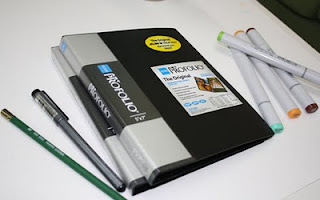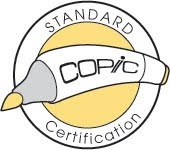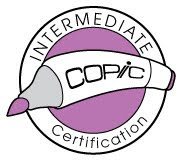Happy New Year! Portfolios
PortfoliosIf you have ever met me at a demo or class, you may have had the opportunity to see one of my portfolios. I never travel without them, so if you see me out at an event, just ask to see them. I am
always happy to share these, as I appreciate the chance to get feedback or to see what catches people's eye first. As 2012 is getting started, now is the time to work on New Year's Resolutions, and maybe one of those resolutions should be to work on your
own portfolio.

This new year, I urge you to start a physical portfolio (not a digital one), especially if you have never kept one before. In the Intermediate class, you are given a small portfolio to begin with. Now, in the standard class you are also given one. We wouldn't include these if we didn't think they were so important! If you would like to pick one up similar to the ones we use, you can find them at any art store, or you can easily make your own.
(Next week I will talk more about picking a portfolio and what to put in it).
The purpose of a portfolio
Any artist or crafter should keep a portfolio of their best work. This is a tool for improvement, and should not be considered a "bragging book". A good portfolio allows you, and your viewer, a chance to see your best work and give each piece individual, critical examination. By keeping work in one, central place, it is easier to compare and improve quality from piece to piece.
In my opinion, if you are an instructor, you NEED to have a portfolio and be willing to share it with your students.
As nice as photographs and blog posts are, nothing compares to being able to see an original work. The computer can be very deceptive, as it interprets colors differently than our eyes and shows work at whatever scale it wants to. Sometimes, you really need to see how big something is in real life, and not shrunk down on a computer screen. Looking at a portfolio is important for both the viewer as well as the creator.
Here are some of my personal thoughts on how to be a good portfolio viewer.
Etiquette in viewing portfolios Give praise but don't gush. When people look through my portfolios, yes, I like to hear "Oh my goodness! That is amazing!" but I would rather hear "Oh my goodness! That is amazing. How did you do that technique?" I want a chance to teach through my artwork.
I never want to hear "You are sooo good. I could never be like you." It is nice to compliment, but don't embarass them by going over the top. Give sincere compliments and remember that with practice you could make work like theirs, or vice-versa.
A portfolio is not a tool for you to compare your work to another person. This is a self-assessment and feedback tool. Don't look at someone else's portfolio and feel bad about your own work. We are all at different places in our work at different times. A portfolio is of a person's best work, so when you look at it, try not to compare your problem areas with their strengths. Use other people's portfolios as inspiration and learning tools, ask constructive questions (mixed in with healthy praise).
Take notes. If you see something you really like, be it the way they shaded an image or colored hair, ask about their technique and practice it.
One time I really wanted to work on making round gemstones look luminous. So, I drew an image with lots of round gemstones. Then, I looked through an artbook by James Christensen to color the gemstones. He is an oil painter, and does a fascinating job rendering luminous stones. There are a couple pieces in my portfolio that are inspired by James Christensen. I could not have improved my technique as quickly without studying his work. This is a good use of another person's portfolio (in this case, an artbook).
Ask before you photograph. Never photograph someone else's portfolio without their permission, and never publicly display those photos without their permission and without giving them credit. Come back to the notes or photos, then try to incorporate those techniques into your own work. There is a saying in art "Copying is the greatest form of flattery." It is OK to copy techniques and colors you like, but whenever possible, attribute credit where it is due. Sometimes for legal reasons you cannot display photos of their work, as those pieces might be published or the rights might belong to someone else. In that case, you could face a potential lawsuit, so always get permission! Be considerate with your flashes, as original works may be light sensitive.
Ask before you touch. If you try to photograph an image and it is behind a piece of plastic, many times the glare will prevent you from getting a decent photo. Or, sometimes, you want to see a technique really close up, or you want to see the back of the paper to see how the ink soaked through. Always ASK before you touch the original. Flipping through plastic pages is one thing, touching the original is another.
In libraries, you are expected to wear linen gloves when touching original works. This is because each time you touch an original, your oily hands are transferring grease onto a project. Copic markers do not like oil and grease, so if a person tries to color that art again, it may not react the same. If you must touch an original, touch the edges, and avoid important features.
Try not to hover. If it is your own portfolio, you may really want to hear feedback. It is OK to hover and explain your work, but it is also OK to not feel obliged to stand there while they look through it. Be courteous to the viewer and consider if you are being over-protective and hovering. Sometimes that makes them uncomfortable, so try to be aware of their comfort level as well.
Next week I will have Part 2 about portfolios, meanwhile, have a wonderful and safe New Year!
 North American Standard Certification
North American Standard Certification










